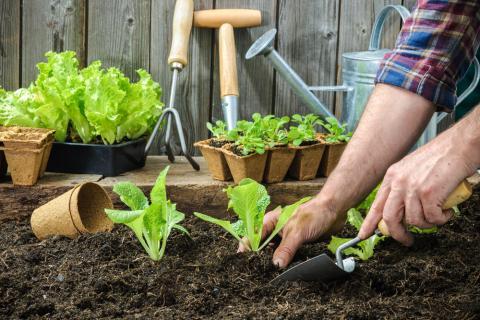
June is one of my favorite months. While April and May bring the promise of buds (and sometimes May gardening is plain delightful), June brings flowers: showy rhododendron, brilliant iris, scented lilac, and delicate poppies burst into bloom. Across the country temperatures begin to rise and days get longer, meaning early sunrise watering sessions or late-night tea out on the deck. If you’ve delayed getting your seeds into the ground, hurry now! You have a few weeks if you live in an area with longer growing seasons. Otherwise, transplant young plants into your garden to get a head start.
Not sure what else to do? Here’s how to garden this month: June.
Harvest Some, Plant Others
If the last frost date was well before spring, some of your spring plants may be ready to harvest. Lettuces grow quickly, and just as quickly bolt. Don’t let this happen! Watch lettuce, spinach, kale, and other greens for fast-growing stalks that taste bitter. Harvest early for the best taste.
If your last frost date just ended, you can likely transplant late-summer vegetables, like zucchini, squash, corn, tomatoes, peppers, and eggplants.
Continue Cleaning
If you still haven’t gotten around to cleaning your garden, now’s the perfect time to weed, rake up dead leaves/buds, deadhead flowers that have already come and gone, and remove any dead branches.
Start the Mowers
With the increase in daylight and rise in temperature, most lawns will start growing faster. Begin mowing more regularly or, better yet, replace your lawn with a garden.
Plant Bulbs
Hoping for spectacular dahlia blooms? Plant your bulbs now to get colorful July and August shows.
Watch for Disease
If you haven’t already struggled with pests this season, just wait—they’re coming. Luckily that doesn’t mean the end of your vegetables or fruit. Applying a mixture of neem oil, natural dish soap, and water can protect against aphids and other pesky insects, but a stop at your local nursery can provide you with protection specific to your plants. Be sure to look for organic options over pesticides or insecticides. Also, just because it’s not obvious doesn’t mean the bugs aren’t there. Examine both sides of leaves as well as the stem for pests.
Water for Drought
Not all areas suffer from drought, but it’s important to be water-wise no matter your location. Water early in the morning before the sun is at its peak to allow plants to absorb the H2O before it dissipates. For those in a drought, water regularly, never allowing your plants to become overly parched.
Help a Plant Out
Tomatoes and beans may have begun to take off. Stake tomatoes as they begin to grow and pinch off suckers to encourage larger, sweeter fruit. Support beans with a net or stake, depending on your growing method.
Guard Your Fruit
Looking forward to peaches, nectarines, or cherries? Guard your fruit by netting all fruit trees to avoid having your produce picked by birds. Watch for fruit that may be getting ready to drop so that rotten, rather than fresh, fruit doesn’t become your reward.
Feeders & Bird Baths
If you hang bird feeders, now is a great time to clean them. Dump out any moldy bird seed and rinse feeder with a mixture of hot water and vinegar in a 3:1 ratio. Dry well and refill. If you have hummingbird feeders, repeat procedure, and refill with a sugar-water mixture. Always avoid honey (due to its molding abilities) and red dye (as it can be toxic to hummingbirds). If you have a bird bath, empty and scrub any slimy sides, then refill with fresh water. Ensure that there is no standing water in your yard to prevent mosquitoes and other water-breeding insects.
Increase Beneficial Insects
Not all insects are pests—in fact, most of them are incredibly beneficial in our gardens and extremely necessary for healthy soil. Purchase worms, ladybugs, praying mantis, or other beneficial insects from your local nursery and apply to your garden. This can also be a fun way to get kids in the garden.
How are your preparing your garden this month? What tasks are must-dos as we enter the beginning of summer?








